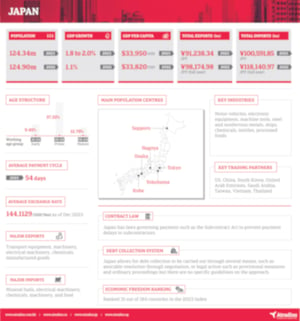

Trade in Asia - Japan
Insights
Japan: An Economy in Transition
Japan is on the brink of emerging from decades of deflation and an ultra-accommodative monetary policy regime – if a revival in domestic demand continues to hold. The economy slipped into a technical recession in the middle of fiscal year 2023 – which cost the country its position as the world’s third-largest economy – but the government expects to see a slightly higher real GDP growth of around 1.6% in fiscal year 2023, up from 1.5% in 2022.
While the growth momentum seems to have temporarily stalled Japan’s anticipated economic normalisation in 2024 comes with the promise of a re-energised economy, which can offer foreign investors a unique opportunity to capitalise on a highly stable and advanced market with a reliable manufacturing backbone. And indeed, that sentiment pushed the Nikkei stock benchmark to rally to a 34-year high in early 2024.
Japan at a glance

State of the economy
External factors shaped Japan’s economic performance in 2023 and will continue to do so this year. Export growth was muted (estimated to be 2.1%) as higher interest rates and recession fears in the US and Europe curbed demand. This slowdown will likely persist into the first half of 2024, before gradually easing in the second half as the anticipated soft landing and interest rate cuts come into effect.
As such, Japan is set to grow at a lacklustre 0.7% in 2024. In anticipation, the government announced a supplementary budget in November 2023 of 21.8 trillion yen (USD146 billion; equivalent to 3.9% of GDP) to mitigate the impact of inflation on households and boost investment in key areas like artificial intelligence and semiconductors.
Inflation, which is exceeding wage growth and expected to reach 3.0% for fiscal year 2023, poses a potential threat to the fragile recovery in domestic consumption, crucial for overcoming deflation. Recent labour market reforms aimed at gradually increasing stagnant wages and enhanced social spending are intended to mitigate the decline in household spending power.
In fiscal year 2024, the government will focus on improving the environment for wage increases, supporting small and medium-sized enterprises, and promoting the reskilling of workers.
__________________________________
This three-pronged approach is designed to underpin private consumption – and eventually help pave the way for the Bank of Japan (BOJ) to make bold monetary policy changes later this year.
_________________________________
Indeed, 2024 is heralded as a pivotal year for Japan. After three decades of deflation, prices have been rising and the BOJ has signaled it will begin unwinding its long-running negative interest rate policy as the bank nears its 2% inflation target. Higher domestic interest rates coupled with rate cuts in the US should also ease the pressure on the yen, which has depreciated about 20% against the US dollar since 2021.
 Meanwhile, the ongoing diversification of the global supply chain has allowed investors to see Japan in a new light. The government of Prime Minister Fumio Kishida is pushing to attract more foreign direct investments, with a goal of reaching 100 trillion yen (USD670 billion) in investments by 2030. The country has already seen an influx of large-scale investments, including the more than USD20 billion commitment from the Taiwan semiconductor giant TSMC to build two factories in southern Japan. Wage increases should also bode well for industries trying to attract skilled labour for these new factories.
Meanwhile, the ongoing diversification of the global supply chain has allowed investors to see Japan in a new light. The government of Prime Minister Fumio Kishida is pushing to attract more foreign direct investments, with a goal of reaching 100 trillion yen (USD670 billion) in investments by 2030. The country has already seen an influx of large-scale investments, including the more than USD20 billion commitment from the Taiwan semiconductor giant TSMC to build two factories in southern Japan. Wage increases should also bode well for industries trying to attract skilled labour for these new factories.
Challenges and risks
Although the BOJ’s policy pivot is not expected to have a significant impact on overall liquidity or credit, an interest rate hike risks curbing capital expenditure and constraining cash flow, particularly for companies operating in rate-sensitive sectors such as construction.
This is a worry at a time when weaker export demand has already impacted some companies’ cash flows, an issue highlighted by our Payment Practices Barometer 2023 report where Japanese companies voiced concerns about delayed payments by B2B customers. Late payments were largely due to invoice disputes and temporary liquidity issues or insolvencies among B2B customers. However, the report also showed that the average payment term in Japan was 54 days from invoicing compared to an average of 60 days in Asia.
 Structural factors, including an ageing workforce and the country’s unique business culture – such as multi-layered organisational structures that can hinder decision-making – and complex commercial, legal, and regulatory systems, continue to pose a challenge for investors.
Structural factors, including an ageing workforce and the country’s unique business culture – such as multi-layered organisational structures that can hinder decision-making – and complex commercial, legal, and regulatory systems, continue to pose a challenge for investors.
Furthermore, unlike other Asian countries with more liberal approaches to account receivables, Japanese companies insist on punctual payments and counterparty credit risk can be difficult to assess because unlisted Japanese companies are not required to produce financial statements.
__________________________________
As with any foreign market, we believe companies entering Japan need to gain a solid understanding of the country’s commercial culture and build networks in the country before launching full-scale operations.
__________________________________
Economic outlook
The recovery of external demand remains one of the biggest determinants of Japan’s economic outlook. As long as the US and Europe avoid a recession and rates continue to ease, we maintain a positive outlook for the Japanese economy.

Domestically, the government’s labour market reforms should not only help boost consumption and address Japan’s worker shortage, but also lead to better productivity, in turn improving corporate profitability. On the other hand, rising rates could draw attention to Japan’s large government debt as it increases the government’s interest burden, potentially impacting future expenditures, subsidies and taxes.
Overall, Japan remains one of the most preferred investment destinations globally. And with many Japanese companies deeply embedded in global supply chains across a variety of industries, the trade sector is seen as stable and trustworthy. While trade opportunities are plentiful, having access to risk management tools becomes crucial for effectively managing associated trade credit risks, which are a common feature of global trade, regardless of the market. Trade credit insurance is therefore a growing market in Japan and the underlying macroeconomic trends support its increasing adoption as companies seek to protect and grow their businesses.
This article was produced with the help of insights from the following Atradius experts: Masayoshi Edamura, Country Manager, Japan; Sanae Shiratori, Senior Underwriter, Japan; and Yasuhide Kumon, Claim Coordinator, Asia.
All content on this page is subject to our Disclaimer, available here.

